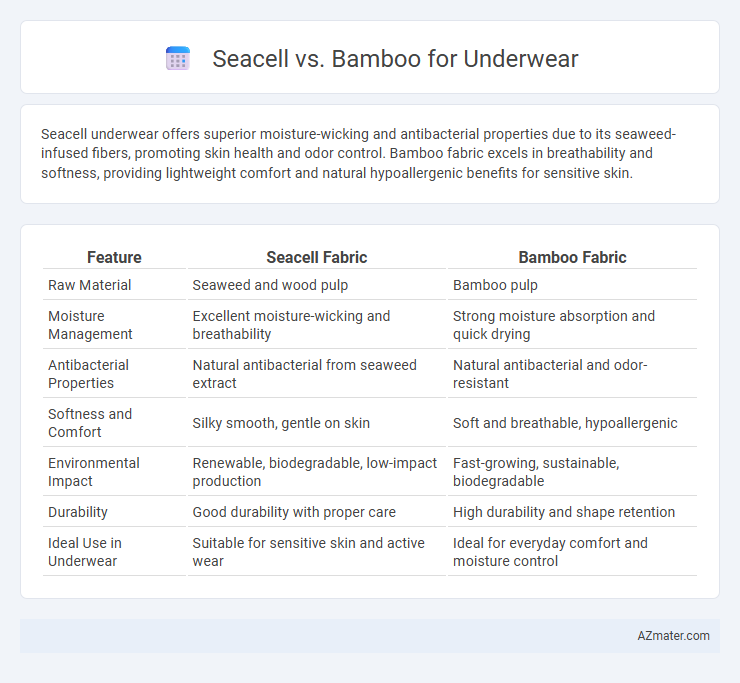Seacell underwear offers superior moisture-wicking and antibacterial properties due to its seaweed-infused fibers, promoting skin health and odor control. Bamboo fabric excels in breathability and softness, providing lightweight comfort and natural hypoallergenic benefits for sensitive skin.
Table of Comparison
| Feature | Seacell Fabric | Bamboo Fabric |
|---|---|---|
| Raw Material | Seaweed and wood pulp | Bamboo pulp |
| Moisture Management | Excellent moisture-wicking and breathability | Strong moisture absorption and quick drying |
| Antibacterial Properties | Natural antibacterial from seaweed extract | Natural antibacterial and odor-resistant |
| Softness and Comfort | Silky smooth, gentle on skin | Soft and breathable, hypoallergenic |
| Environmental Impact | Renewable, biodegradable, low-impact production | Fast-growing, sustainable, biodegradable |
| Durability | Good durability with proper care | High durability and shape retention |
| Ideal Use in Underwear | Suitable for sensitive skin and active wear | Ideal for everyday comfort and moisture control |
Introduction to Seacell and Bamboo Fabrics
Seacell fabric is derived from natural seaweed fibers combined with cellulose, offering moisture-wicking and skin-soothing properties ideal for underwear. Bamboo fabric is made from bamboo pulp, known for its breathability, antibacterial qualities, and softness, making it a popular choice for intimate apparel. Both materials provide eco-friendly alternatives, with Seacell boasting antioxidant benefits and Bamboo emphasizing temperature regulation.
Key Differences Between Seacell and Bamboo
Seacell underwear features fibers infused with seaweed nutrients that offer natural skin-soothing properties and enhanced moisture retention, while bamboo fabric is prized for its breathability and antibacterial qualities derived from bamboo pulp. Seacell fabric provides a unique combination of environmental benefits and skin health support due to its bioactive compounds, whereas bamboo underwear excels in softness and temperature regulation. The key differences lie in Seacell's infusion of marine elements promoting skin vitality versus bamboo's sustainable production emphasizing comfort and odor resistance.
Environmental Impact: Seacell vs Bamboo
Seacell underwear is made from a blend of cellulose fibers derived from seaweed and wood pulp, offering a biodegradable option that supports ocean sustainability by utilizing renewable marine resources. Bamboo fabric, sourced from fast-growing bamboo plants, requires less water and pesticides compared to traditional cotton, making it an eco-friendly choice with strong carbon sequestration properties. Seacell production involves a closed-loop process to minimize chemical waste, whereas bamboo processing varies widely and often relies on chemically intensive methods, impacting its overall environmental footprint.
Comfort and Softness Comparison
Seacell fiber, infused with seaweed extracts, offers superior moisture-wicking and antibacterial properties, enhancing overall comfort when used in underwear. Bamboo fabric provides exceptional softness and breathability due to its micro-gauge fiber structure, making it highly gentle on sensitive skin. Comparing the two, Seacell excels in durability and skin benefits, while bamboo outperforms in plush softness and thermal regulation, creating distinct comfort profiles for underwear fabric choices.
Breathability and Moisture-Wicking Abilities
Seacell fabric, made from seaweed fibers, offers natural breathability and excellent moisture-wicking properties, making it ideal for comfortable underwear that stays dry and fresh. Bamboo, known for its porous structure, provides superior airflow and highly efficient moisture absorption, which helps regulate temperature and reduce sweat buildup. Both materials outperform traditional fabrics by promoting ventilation and quick drying, but bamboo typically excels in moisture management due to its higher absorbency rate.
Antibacterial Properties: Which Is Superior?
Seacell underwear incorporates seaweed fibers rich in natural antibacterial compounds that inhibit bacterial growth and reduce odor, offering enhanced hygiene benefits. Bamboo fabric is inherently antimicrobial due to its natural bio-agent, but Seacell's unique integration of marine nutrients provides superior antibacterial performance. Studies show Seacell fabrics maintain prolonged antibacterial efficacy, making them a top choice for hygiene-focused underwear.
Durability and Longevity
Seacell underwear, made from fibers derived from seaweed, offers excellent durability due to its natural moisture-wicking and antibacterial properties that help fabrics maintain integrity over time. Bamboo underwear is highly breathable and soft, but tends to degrade faster with frequent washing compared to Seacell blends, which are engineered for enhanced longevity. Both materials promote comfort, yet Seacell's superior resistance to wear makes it a better choice for long-lasting underwear.
Skin Sensitivity and Hypoallergenic Features
Seacell underwear, derived from seaweed fibers, offers natural moisturizing properties and is rich in antioxidants, making it highly suitable for sensitive skin and providing hypoallergenic benefits. Bamboo fabric is renowned for its breathability, moisture-wicking ability, and antimicrobial properties, reducing irritation and preventing the growth of bacteria, which is ideal for those with skin sensitivities. Both materials promote comfort and reduce allergic reactions, but Seacell's unique bioactive properties give it an edge for enhancing skin health in hypoallergenic underwear.
Cost Considerations and Accessibility
Seacell underwear typically comes at a higher price point due to its premium natural fiber blend infused with seaweed, offering skin-soothing and eco-friendly benefits. Bamboo underwear, while also sustainable and moisture-wicking, generally costs less and is more widely available in mainstream markets and online retailers. Consumers seeking affordable, accessible options often prefer bamboo, whereas those investing in luxury or specialized skincare properties lean toward Seacell despite the higher cost.
Final Verdict: Seacell or Bamboo for Underwear?
Seacell underwear offers superior moisture-wicking and skin-soothing properties due to its seaweed-infused fibers, making it ideal for sensitive skin and those seeking natural antibacterial benefits. Bamboo underwear excels in breathability and sustainability, with fibers that provide softness and durability while supporting eco-friendly production. Choosing between Seacell and Bamboo depends on whether you prioritize skin care benefits and advanced fiber technology or maximum breathability and environmental impact.

Infographic: Seacell vs Bamboo for Underwear
 azmater.com
azmater.com